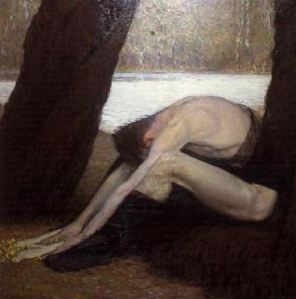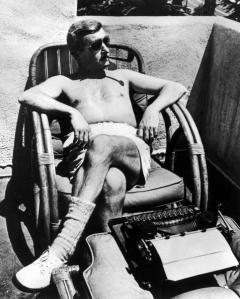When Inspiration Needs a Nudge
I’ve written earlier about what I consider to be the seven stages of writing:
Inspiration
Incubation
Perspiration
Evaluation
Extermination
Resurrection
Projection
There are links to this post and one about inspiration at the end of this post but today I’m going to focus on some practical suggestions regarding inspiration.
Every writer knows that time when the wells of inspiration seem to have dried up. It’s not writer’s block but it has the same effect. Your creative path peters out and you are left feeling there’s no way forward. 
This post is about some ways I’ve found to help nudge inspiration when it’s gone off down the road for a cup of tea, perhaps in a huff at being overworked. Come back inspiration, all is forgiven.
I once read some research which found that when people who were considered creative were analysed, poked and prodded the one overall cause of their creativity was found to be this: That they considered themselves to be creative. They had experienced creativity in the past and they assumed that they would continue to be creative in the future. I’ve no idea where this research came from nor whether it is valid but I like the idea as it’s one which encourages writers whose inspiration is floundering to pick ourselves up and carry on.
Here are some things which work for me.
Find somewhere to be inspired. Think of the places where you’ve been inspired before and go back to them. It might be some bucolic place, (remember how Wordsworth got inspired gazing at Tintern Abbey) but it might equally be in the hustle and bustle of a big city. I get most of my good ideas when I’m sitting in a café. I’ve no idea why. It may be something to do with being away from my normal writing environment, it may be to do with the sense of anonymity, it may be the opportunities the place gives me to be a silent observer. Wherever you go, please remember to take a notebook with you. A notebook is one of the essential tools of creativity; the best place to capture those inspirational thoughts which are as ephemeral as clouds.
Putting on Heads. Win Wenger Phd is an unusual thinker. ‘The Einstein Factor’ a book he wrote with Richard Poe gives lots of great ideas and his web-site gives more. http://www.winwenger.com/wenger.htm
Inevitably you may find some of Wenger’s ideas great, others weird, others unworkable. Here’s one I particularly like called Putting on Heads. The basic idea is that you put on the head of a genius or mentor and try to experience the world with her or his senses and think about these experiences with their minds. Check out the book for more information on how to do it.
I used to travel a lot to do training and once I left my home in the West Country of England to go to London. I was in a terrible hurry so imagine my consternation when I got on the train and realised that I’d left my notebook and the novel I was reading on the dining room table. How would I fill the two hour journey? I decided to try out Putting on Heads. First I became Napoleon and viewed the landscape as he might have done. I had the Old Guard lurking behind a hill, Dragoons and Lancers charging across the meadows.
But after a while I got bored and decided to put on the head of a mystery writer instead. (I recommend this for long train journeys) The woman sitting beside me slumped against my arm. As Martin Lake I would have assumed she was asleep. As Agatha Christie I assumed she’d been murdered. A man walked into the carriage and looked around as if perplexed before turning and hurrying away. Was he merely an ordinary passenger who had returned from the toilet and walked into the wrong carriage or was he Richard Hannay watching for the Police working their way through the carriage in search of him?
Try putting on heads as an aid to creativity. It really works.
The Disney Strategy. This is a term coined by Robert Dilts. When he was researching creativity a cartoonist from the Disney studios said there were three Walt Disneys: The Dreamer, the Realist and the Spoiler (or critic.) To be a dreamer you need to ignore the other two personas and adopt a playful, child-like, inquisitive posture. I use the word posture deliberately. Dilts finds that if you lean back, look up and focus your eyes on the skies rather than the ground you’re more likely to come up with ideas. Check out Robert’s web-site http://www.nlpu.com/NewDesign/NLPU.html for more information, buy his books or, better yet, go on one of his courses.
The Moving Finger.
Think of five numbers. Pick up a book, any book. Open the book at the page corresponding to the largest number. Select the paragraph which corresponds to the smallest number. Use the other numbers in this way. Let’s say they are 7, 3 and 10. Find the seventh noun in the paragraph, the third adjective and the eleventh verb. Here’s what I’ve found from the novel Fever by Mary Beth Keane.
Noun: knot, Adjective: young, Verb: cxplain. My immediate inspiration from these words is a story about how a young boy trying to explain why he’s tied a knot around his friend’s neck. Or perhaps around his own.
Martin’s Creativity Game. I’m indebted to Suzi Smith for introducing me to the idea in a different context. I’ve changed it to suit the needs of the writer. http://suzismith.net/
Here’s what to do:
Go for a walk with a notebook and note down seven things which grab your attention.
Find somewhere quiet to work (or a noisy bustling café if that suits you better.)
Write seven topic heading on one sheet:
Here are some suggestions:
Protagonist, antagonist, genre, conflict, opening scene, climax, resolution.
You may want to choose others or mix and match. It really is flexible.
Let’s assume on your walk you noticed: a flower, a snoozing dog, a child on a swing, a solitary cloud, a glove on the ground, a window which slammed shut, an abandoned bicycle.
Here’s what to do next. Ask yourselves these questions:
In what ways is your protagonist like or unlike a flower?
In what ways is your antagonist like or unlike a snoozing dog?
In what ways is your stories’ genre like or unlike a child on a swing.
And so on.
Then step back and read what you’ve come up with. Is there a story lurking here? If not can you see if changing the linkage of objects to topics produces a better result.
What are your suggestions for nudging inspiration? Please leave a comment with your ideas and I’ll collect them together for a future post.
Related articles
http://martinlakewriting.wordpress.com/2013/10/01/seven-stages-of-writing/
http://martinlakewriting.wordpress.com/2013/10/18/inspiration/
Don’t Stop: 6 Tricks for Beating Creative Blocks (shutterstock.com)







